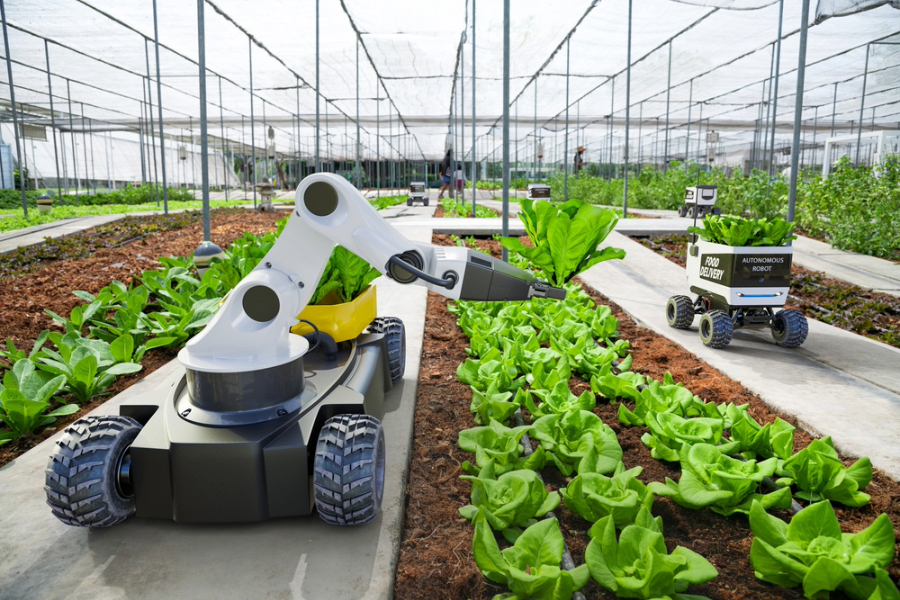AI Descends Labour in Global Agriculture
The idea that labor capacity is always reduced and replaced by technological advancement is propagated by current researchers and public media, especially in labor-intensive industries like agriculture. However, Bessen’s (2016) analysis of AI’s effects on labor shows that historically, the reverse has been true. The adoption of AI technology has, in general, made it possible for some businesses to create new, more complex employment prospects. This has also made it possible to absorb labor from other areas that are experiencing a labor shortage, such as the I.T., financial, and logistics sectors. However, some industries, like agriculture, are more likely to see a significant decline in labor as a result of the use of AI technology. As demonstrated over the past 100 years, as farming has become more mechanized, labor demands have significantly decreased.
AI in US Agriculture
In the USA today, employment in agriculture accounts for less than 2% of all labor, compared to 40% in the early 1900s. “A machine-based system that can, for a given set of human-defined objectives, make predictions, recommendations, or decisions influencing real or virtual environments” is how the OECD defines artificial intelligence (AI). In this sense, artificial intelligence (AI) refers to cloud computing, software, big data (predictive) analytics, and other computer automation. riding the digital revolution’s waves. It manifests as autonomous machinery, GPS-based tractors, smart farming and harvesting techniques, and drones equipped with crop health detecting technologies. Based on these principles, these technologies are engineered to maximize efficiency and surpass natural processes.
Propagation, cultivation, livestock management, crop health, insect control, harvesting, crop production, and other aspects of agricultural management are all covered. While AI automation won’t completely replace labor in the current era, it will happen more frequently. But as the next AI wave draws near, more labor-intensive robots and autonomous machinery will take the place of labor, with most farm laborers managing automation and robots as well as implementing and implementing judgments based on big data (predictive) analytics in agricultural contexts. In the long term, we anticipate that farming and food production will be entirely automated, involving very little (or very specialized) human labor in the areas of cultivation, harvesting, processing, and harvesting.
AI in EU Agriculture
Around 60% of all laborers in Europe worked in agriculture during this period, but that percentage fell to 23% in 1970. It accounted for 5% of all formal employment in the EU-27 in 2010. In the European Union, up to 4.8 million agricultural employment vanished between 2000 and 2012. Artificial Intelligence’s Effect on European Agricultural Labor Food production has expanded dramatically during the past century, despite a decline in employment in agriculture. Food has always been produced since it is a basic human requirement and an important economic good.
Both the European Commission and individual EU nations now prioritize food security as a key area of policy concern. Researchers are interested in learning more about how technology innovation affects the agriculture industry and, therefore, the labor force engaged because of this condition. According to Oxford Economics (2019), automation has replaced up to 2% of the global labor force in general manufacturing since 2000, and by 2030, it has the potential to replace up to 10% of this labor force. What long-term effects AI automation may have on agricultural labor in the EU’s agriculture industry is uncertain.
AI and Economy
Farmers operating autonomous farms will need to learn new skills and use management agricultural equipment more frequently. AI will also help with sustainable economies and pave the path for the restoration of natural ecosystems that have been devastated by excessive resource consumption. Overall, all scientific research on the impact of automation and robotics on the labor market is developed from a macroeconomics standpoint, using aggregate data on the labor force, occupation, productivity, and other factors. To be relevant and competitive in the global economy, the European Union has moved toward artificial intelligence. Furthermore, it would eventually become more expensive for farms to hire labor due to the rising minimum wage. Increased production efficiency, which AI can do to reduce inputs and eliminate food waste, is another factor driving the shift to AI.
Nevertheless, in the case of agricultural output, such data, while accessible, do not fully capture the labor force, particularly when it comes to low-skilled labor, which makes up the bulk of workers in agriculture in many countries. This is because there are a lot of seasonal and unregistered workers in the agriculture industry.
Source

